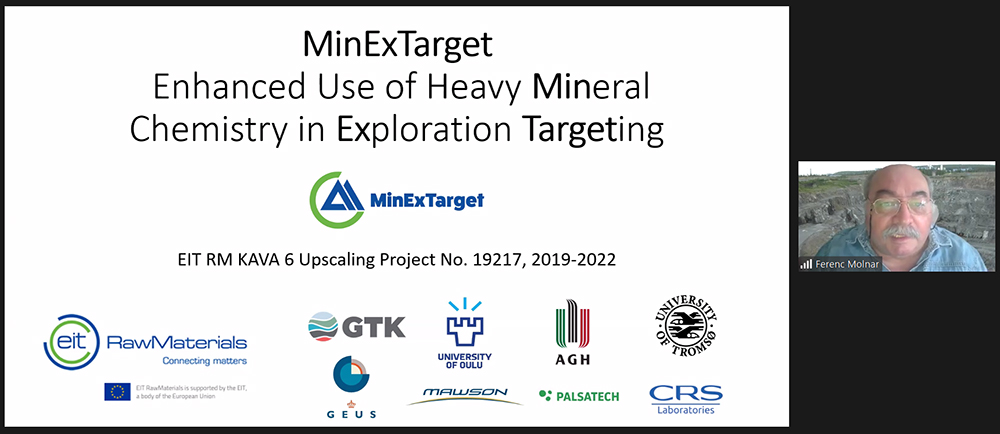In the period from 14th till 18th of June 2021, Master and PhD students as well as early-stage professionals were invited to participate in the five days online short course on “Fingerprinting techniques in mineral exploration – Discover the mineral potential of Fennoscandia and Northern Europe”.
The short course was organised by MinExTarget project and ran from UiT – The Arctic University of Norway, in collaboration with AGH University of Science and Technology, Geological Survey of Denmark and Greenland (GEUS), Geological Survey of Finland (GTK), University of Oulu (OU), and EIT RawMaterials Academy. The course combined a series of lectures with practical work in small groups.
After Dr. Yulia Mun, a postdoc in the MinExTarget project, opened the short course and welcomed all participants, Lotta Aalto, Education Officer at EIT Raw Materials, introduced the audience to the concept of EIT Raw Materials Academy and presented the educational and networking opportunities for students in study programs relevant for the entire mineral sector.

Figure 1. Lotta Aalto, Education Officer at EIT Raw Materials, is presenting the activities of EIT RM Academy.

Figure 2. Prof. Ferenc Molnár, the project Scientific Coordinator, is presenting the innovative concept of the MinExTarget project.

Figure 3. Dr. Henrik Schiellerup is talking about the role of the Geological Survey of Norway in mapping the mineral potential of Norway.
Ferenc Molnár, Scientific Coordinator of the project, gave an introduction to the innovative concept of MinExTarget project.. The first day of the course was focused at the geology and mineral potential of the Fennoscandian Shield and Northern Europe.
Day 2 was devoted to geochemical exploration methods, emphasizing sampling strategies in glaciated terrains and application of stream sediments and marine sediments in mineral exploration.
During Day 3, the participants got an overview of mineral exploration techniques in deeply weathered and covered terrains as well as an introduction to geoanalytical methods in mineral exploration, including beam-based technologies, stable isotope analyses and fluid inclusions studies.
Day 4 was oriented to the selected case studies, such as application of trace element content of pyrite as a potential tool for mineral exploration targeting, and mineral trace element and isotopic footprints of orogenic gold deposits in Finland. Also, the participants were introduced to processing and fingerprinting of mineral trace element data by unsupervised machine learning and data analysis techniques and the CODA approach.
The last day of the short course was mostly focused to integration of geochemical databases into the decision-making procedure of mineral exploration targeting.
25 students were selected based on their motivation letters, to participate in the practical part of the course. The participants were invited to work in small groups to solve exploration tasks.
Good feedback
In total more than 80 participants from more than 25 countries were following lectures, while the practical work was limited to 25 students working in five groups. The short course was well accepted by both the participants and presenters. In addition to its educative goals, the course served as a good arena for networking of students and professionals from all over the world. The students have found the practical work in small groups particularly attractive and motivating.
We received positive feedback from participants:
“I have found this workshop to be very educational and informative. This workshop has provided me with specific hands-on skills that will be invaluable in my professional and personal life. It has given me a chance to put into practice what I have learned. It is encouraging to know that there are multiple ways to understand and handle a problem.”
“All the presenters especially Sabina Strmic Palinkas and Alan Butcher were very knowledgeable and provided a pace for questions about the Fingerprinting techniques in mineral exploration and resources you can tap into.”
“Great workshop and great course content”
“I really enjoyed the small group dynamics – especially as they were all lovely people. I highly recommend it to anyone who wants to get an overall idea of Fingerprinting techniques in mineral exploration.”
Also, we got multiple requests to organize again the short course in coming years.
Sabina Strmic Palinkas & Yulia Mun
UiT The Arctic University of Norway



